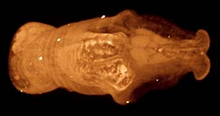

| Caudofoveata | |
|---|---|

| |
| Anterior 1.4 mm of a fixed and stained specimen of Falcidens sp. | |
| Scientific classification | |
| Domain: | Eukaryota |
| Kingdom: | Animalia |
| Phylum: | Mollusca |
| Class: | Caudofoveata |
| Families and genera | |
Caudofoveata is a small class within the phylum Mollusca, also known as Chaetodermomorpha. The class is often combined with Solenogastres and termed Aplacophora, but some studies have cast doubt on the monophyly of this group.[1]
Caudofoveata are worm-like molluscs ranging 0.02–10 cm in size, but one species, Chaetoderma felderi, can reach 36.5 cm. The foot is completely absent, and instead of a shell their mantle is covered in calcareous spines called sclerites.
Caudofoveates live by burrowing through soft sediment, and feed by lying vertically in the sediment with just the mouthparts exposed and taking in passing organic detritus. During sexual reproduction, the female produces eggs which are fertilized and brooded, and then the larvae swim freely.
Caudofoveates are deposit feeders, or more selective detritivores or predators of foraminifera.[2][3]
Caudofoveata comprises the following families and genera:[citation needed]
There are 15 genera, with about 150 known species.
| Caudofoveata |
|
|---|---|